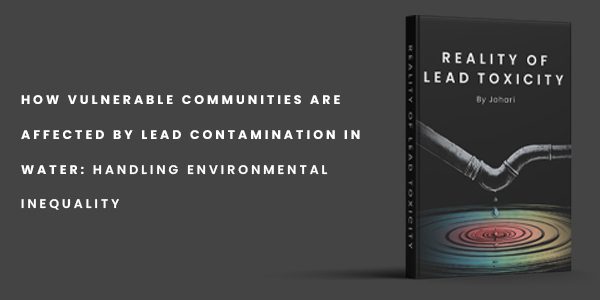Drinking water contaminated with lead is a serious public health concern that has numerous effects, especially for marginalized people. All groups are concerned about lead exposure, but marginalized and underserved communities are disproportionately affected. This blog talks about the causes of environmental inequality, the effects of lead contamination on these communities, and the necessary steps to take in order to resolve this pressing problem.
The Scope of the Problem
When lead fittings, pipes, or solder in plumbing systems corrodes, lead seeps into the water supply and causes pollution of drinking water. This issue is widespread around the world, in both developed and developing nations, and is not specific to any one area. On the other hand, not all impacts of lead exposure are felt equally. Lead pollution affects vulnerable communities largely; lower economic levels, minority status, and past neglect often define these communities.
The Reasons Vulnerable Communities See Higher Impact
The following factors increase the risk of lead exposure in communities that are already at risk:
Aging Infrastructure: Older plumbing systems and lead pipes are common in low-income communities and historically neglected areas. These communities are more likely to lack the funds necessary for replacing or upgrading their infrastructure, which increases the risk of persistent lead exposure.
Economic Disparities: Due to financial constraints, a large number of families in marginalized communities reside in older homes that have lead-based plumbing and paint. They frequently lack the resources to pay for sophisticated water filtering systems or lead removal services.
Lack of Information: People living in underprivileged areas might not have easy access to information regarding lead poisoning and the health hazards it poses. This ignorance may cause a delay in determining and reducing lead exposure.
Regulatory Oversight: In underserved areas, regulatory bodies may not always enforce standards or offer sufficient monitoring. These populations may be put at higher risk because of fewer inspections and delayed responses to contamination-related issues.
Historical Inequities: Low-income and minority neighborhoods are more likely to experience environmental dangers due to historical patterns of racial and economic segregation. These communities frequently experience a confluence of socioeconomic and environmental challenges that increase their susceptibility to lead exposure.
Effects of Lead Contamination on Health
Exposure to lead can have detrimental effects on one’s health, especially for vulnerable populations. Lead poisoning can have both short-term and long-term repercussions on one’s physical and mental health.
Children: Children are particularly vulnerable to the negative effects of lead, which can impair their brain development and result in behavioral problems, learning impairments, and cognitive deficits. Lead exposure increases the risk of lower IQ, attention issues, and difficulties in school.
Adults: High blood pressure, renal damage, and problems with reproduction can all result from exposure to lead. Chronic exposure has been associated with a higher risk of kidney disease, cardiovascular illness, and cognitive impairment.
Pregnant Women Exposure to lead during pregnancy may cause problems for the unborn child, including low birth weight, premature delivery, and developmental problems. If the mother already resides in a lead-contaminated environment, the danger is increased.
Resolving Environmental Inequality
A multifaceted strategy is required to address the problem of lead contamination and its disproportionate impact on communities who are already vulnerable:
Infrastructure Improvements: Replacing lead pipes and enhancing the water infrastructure in underprivileged areas should be top priorities for governments and municipalities. Reduced lead exposure can be achieved by investing in newer plumbing systems and making sure, they are maintained on a regular basis.
More Regulation and Monitoring: Tighter enforcement of water safety laws and increased monitoring are essential. This entails doing routine lead testing on water, especially in high-risk locations, and acting quickly to remove any contamination.
Public Education and Awareness: It is critical to increase public knowledge of lead poisoning and the health hazards it poses. Clear, practical information on how to test for lead, avoid exposure, and pursue treatment must be available to communities.
Financial Support: Low-income families can manage lead dangers by receiving financial support for lead cleanup and home renovations. This could involve funding for household lead abatement initiatives, infrastructure upgrades, and water filter system subsidies.
Advocacy and Policy Change: In order to alleviate environmental inequality, policies might be changed because of advocacy initiatives. It is critical to support activities aimed at reducing exposure in marginalized areas and enhancing environmental justice.
Community Involvement: Working with local authorities and groups can assist in customizing solutions to meet the unique requirements of disadvantaged groups. Working together can guarantee that treatments successfully address local issues and are culturally appropriate.
Conclusion
Water poisoning with lead is a serious social justice issue as well as a technical one. The wider problem of environmental injustice is brought to light by the effects of lead exposure on populations that are already at risk. Through a complete solution implementation and an awareness of the underlying issues contributing to this issue, we may strive towards a equal and healthier environment for everybody. Governments, organizations, and individuals must work together to address lead pollution in order to guarantee that everyone has access to safe, clean drinking water and to address systematic and historical disparities.

